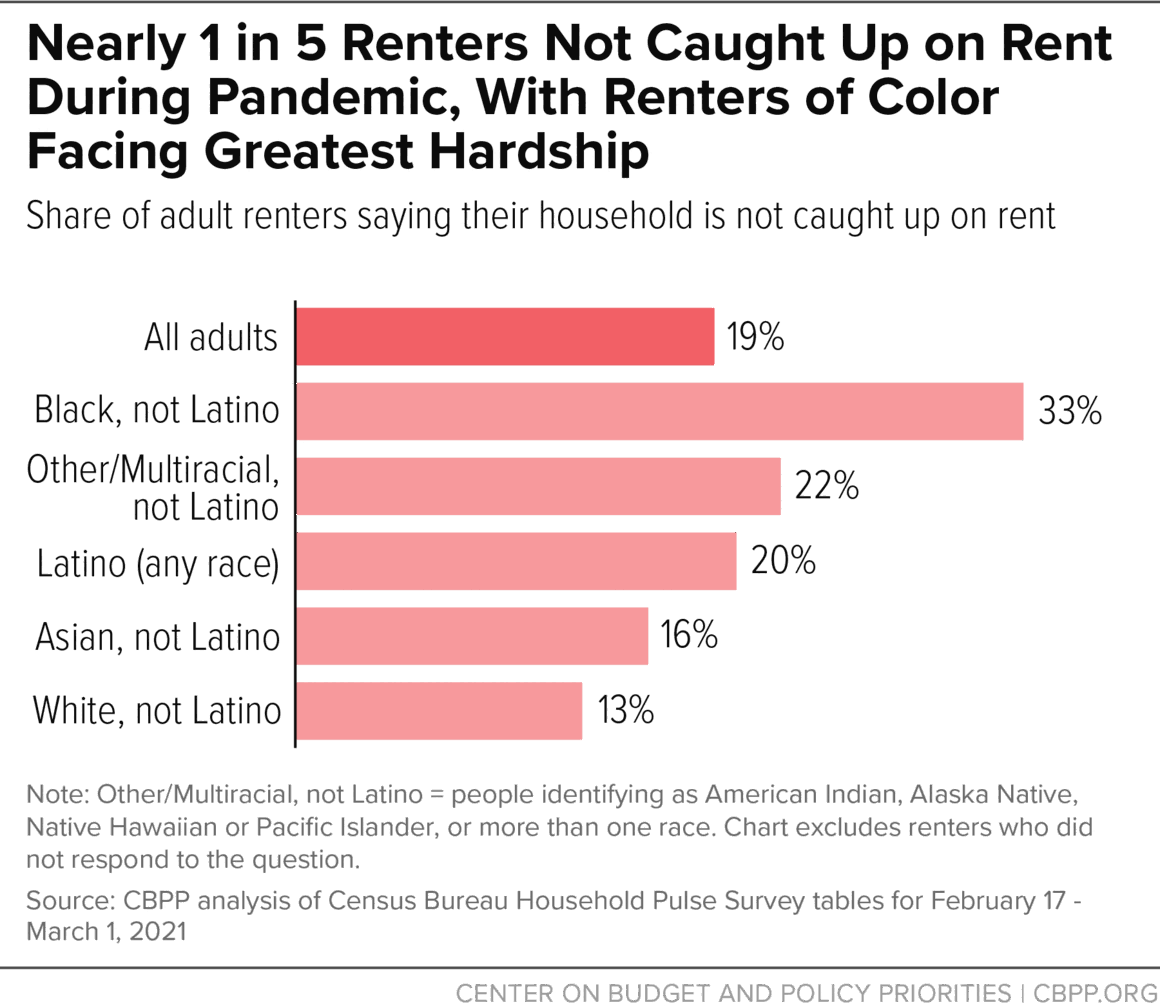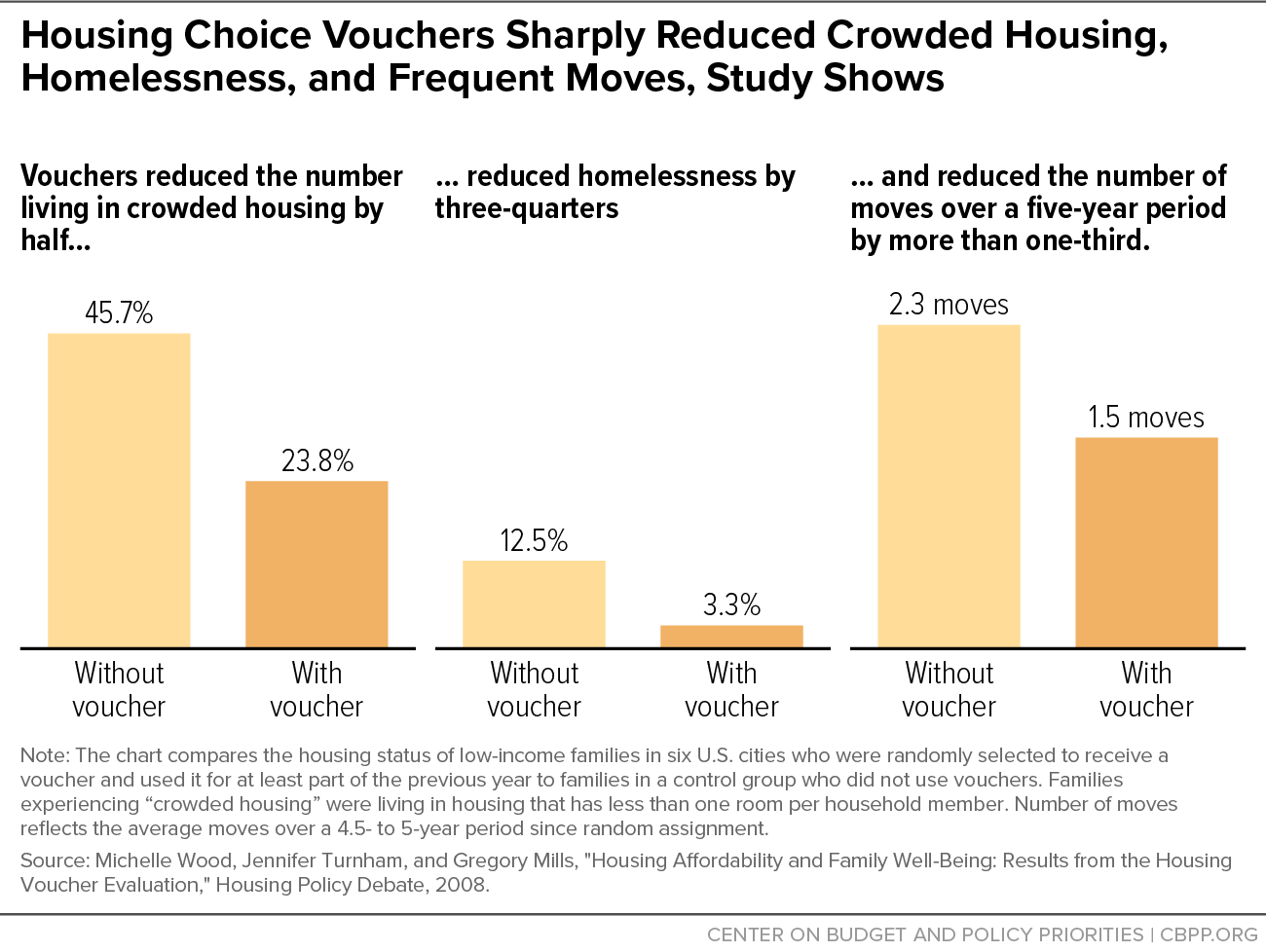The American Rescue Plan Act includes substantial aid for millions of people who are struggling to pay their rent and avoid eviction, as well as badly needed resources to help communities address homelessness during the pandemic.
The COVID-related economic downturn continues to force millions of renters and their families to make tough choices between paying the rent and paying for heating, food, and other essentials. Nearly 1 in 5 adult renters — some 13.5 million adults — recently reported that they are not caught up on their rent payments, according to the latest Census Pulse survey, and more than 5 million renters say they have lost employment income and expect to be evicted soon (see Figure 1).[1] Families with children have been hit particularly hard: 4 in 10 children in renter households are experiencing either housing or food hardship. Black and Latino households, which have experienced disproportionately high job losses during the pandemic,[2] also are much more likely than others to report that they are either not caught up on rent or are not getting enough to eat.
Communities are also struggling to provide safe, non-congregate shelter and housing options to the more than half a million people experiencing homelessness. Adding to the urgency of addressing these problems, emerging evidence shows that evictions and homelessness may exacerbate the spread of COVID-19 and cause severe hardship.[3]
Policymakers have taken several actions in recent months to mitigate housing-related hardship. The Trump Administration and Congress provided $25 billion for rental assistance in December’s COVID-19 relief package, for example, and the Biden Administration recently extended a Centers for Disease Control and Prevention order prohibiting most evictions through the end of March. This assistance, while substantial, will likely be enough to help only a fraction of the 13 million renters who have fallen behind on their rent. Analysts’ estimates of the amount of back rent these renters owe vary from $1,700 to $6,000 per household, yielding an average estimate of the total back rent owed of nearly $27 billion.[4] And millions of renters are likely to need additional aid to keep up on rent and avert evictions in coming months while the pandemic subsides and the economy recovers.
The American Rescue Plan Act provides a robust, comprehensive package of relief measures to reduce housing instability, homelessness, and other hardship in communities across the country:
- $21.6 billion in emergency aid for low-income renters who have lost income or are otherwise experiencing hardship due to COVID-19 and risk losing their housing. These funds, combined with the renter aid in the December relief package, will help millions of households pay arrearages and keep up on their rent, thereby avoiding eviction or other instability this year. For example, if renters receive an average of six months of rental assistance (including for arrearages), the combined emergency rental assistance in the two packages will help about 4 to 6 million low-income households, we estimate. (The actual number assisted will depend partly on how state and local governments choose to distribute the aid to needy households.) The aid will also indirectly help owners of rental property, some of whom are having difficulty paying their own bills as renters fall behind.
-
$5 billion for Housing Choice Vouchers for people recovering from homelessness and renters at greatest risk of homelessness if they lose their current housing. Housing vouchers are more effective than emergency aid for people who will likely face a longer path to financial stability in the wake of the pandemic. Renters with extremely low incomes and histories of homelessness could risk eviction and hardship when emergency aid runs out; vouchers offer longer-lasting support that can help them remain stably housed as the recovery takes hold. (Recipients can use the new vouchers as long as needed to afford housing, but the new vouchers differ from regular vouchers in that housing agencies may not reissue them to new households after September 30, 2023.) Providing vouchers to this at-risk population will also enable state and localities to target emergency rental assistance — which is limited to 18 months — to renters who need only temporary aid to remain in the homes. Most renters who have lost income and fallen behind on rent during the pandemic will recover quickly as the economy improves.
Housing vouchers are also essential to addressing homelessness effectively during the pandemic. (See Figure 2.) To avoid returning to homelessness, a significant share of people now living in emergency shelters or who have temporary housing subsidies will require affordable or supportive housing over the longer term.[5] The Department of Housing and Urban Development’s (HUD) rigorous Family Options Study found, for example, that more than one-third of formerly homeless families with children experienced subsequent episodes of homelessness or housing instability over a three-year period unless they received housing vouchers or other longer-term rental assistance.[6] Formerly homeless people with underlying health or behavioral health conditions are also likely to face significantly longer recoveries, and housing vouchers paired with mainstream services such as mental health support, health care, or substance use treatment can help provide them with stable housing during that time.
-
$5 billion for homelessness assistance through the HOME Investment Partnerships Program. Communities may use this flexible funding for affordable and supportive housing development, short-term rental assistance, development of non-congregate shelter, and support services for people experiencing or at risk of homelessness, including survivors of domestic violence and veterans. Of particular note, the American Rescue Plan Act will allow communities to acquire commercial properties such as hotels and motels — which are available at relatively low cost in many communities — and convert them to healthier non-congregate shelter, affordable housing, or supportive housing for people living in shelters or unsheltered locations. These investments will help meet immediate needs for healthier housing options for people experiencing homelessness. They also will better prepare homelessness assistance systems for future crises by making a down payment toward the longer-term goals of replacing congregate shelters with housing options that are safer and healthier for people experiencing homelessness as well as the front-line staff who serve them.
Many communities are reporting increases in the number of people living unsheltered due to reductions in shelter capacity (stemming from social distancing requirements) and increases in homelessness related to financial hardship.[7] In order to ensure that the HOME funds are used to meet the needs of people facing the most severe challenges, it will be important for HUD to provide guidance and technical support to HOME grantees in developing their programs and require them to work closely with Emergency Solutions Grants recipients and continuums of care to allocate funds to projects and providers.
- $750 million for housing assistance to tribal nations and Native Hawaiians. Native Americans living in tribal areas and remote Alaskan villages face high levels of overcrowding and substandard housing (such as lack of plumbing and heat), which have left them particularly vulnerable to the spread of COVID-19. Tribes will receive no aid directly from any of the programs listed above, so these separate funds are a critical resource for tribes to reduce housing-related health risks during the pandemic. In combination with emergency rental assistance provided in the December COVID relief package, this funding, which includes formula-based and competitive block grants, will also help Native Americans living in tribal areas or on Native Hawaiian home lands pay back rent and stay stably housed.
The American Rescue Plan Act also includes $139 million for several rural housing assistance programs and $120 million to provide housing counseling services to renters and homeowners and to promote and enforce fair housing. In addition, the bill provides $10 billion in aid for homeowners who are experiencing financial hardship due to COVID to help them keep up on their mortgage payments to avoid foreclosure and displacement, as well as an additional $4.5 billion to help homeowners and renters pay for heating and cooling costs.



